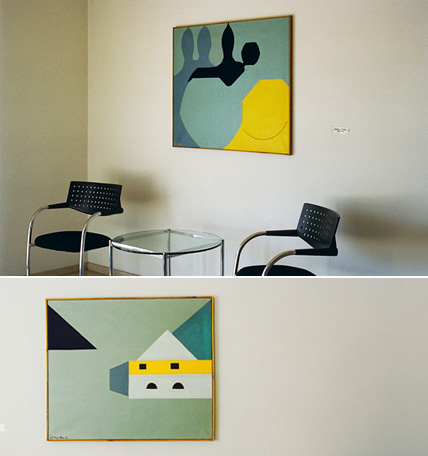| DE / EN |
||||
 Rudolf Urech-Seon Composition P, 1954 – Orient, 1958 Photograph: Katalin Deér, 2011, Verwaltungsgebäude |
 [...] Not until the 1930s did he make his first, as yet tentative attempts to move beyond the Late Impressionist style he had hitherto cultivated. In the 1940s, after many twists and turns, he eventually arrived at an abstract language of forms that his local followers rejected. An invitation to exhibit his paintings at the Galerie “des Eaux-Vives” in Zurich in 1946 opened up a whole new world to him. His contacts with artists in the “Allianz,” an association of modern artists in Switzerland founded in 1937 that enjoyed the support of “de Eaux-Vives,” liberated him from his decades-long isolation and confinement. He became a member of the “Allianz” and began exhibiting his works alongside those of other young “Concretists” like Max Bill, Richard Paul Lohse, and Leo Leuppi. Urech-Seon was never a radical, however. Cautiously inching their way towards abstraction, his works cannot be said to have contributed much to the ultimate triumph of Modernism when the Second World War put it in peril. Only in his late works did the abstraction that had haunted him his whole life long come into its own. He continued to paint in oil, but using an extremely reduced, unmistakable palette. This naive-looking, painterly brand of abstraction, in which figurative fragments still have a place, is lyrical and impure. Only when pictorial narrative reclaimed the place in art that it had lost during the Modernist era did the late works of Urech-Seon at last attract widespread attention and appreciation. Roman Kurzmeyer, 2014 (translation: Bronwen Saunders) |
Art from SwitzerlandHomeNews – November 2020 – March 2020 – October 2019 – March 2018 – October 2017 – April 2017 – January 2017 – May 2016 – December 2015 – May 2015 – March 2015 – December 2014 – August 2014 – May 2014 – October 2013 – April 2013 – July 2012 – March 2012 – November 2011 – May 2011 – January 2011 |